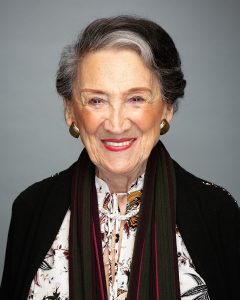
Yvette Siegel-Herzog co-founded Stephen Gaynor School in 1962 along with her friend and colleague, Dr. Miriam Michael, whom she met as a student at New York University. Though the field of special education was in its infancy at the time, the friends saw the need to establish a school for bright students with learning challenges. The pair created a school where the students could thrive, pioneering the individualized, multi-sensory teaching approach used today.
We sat down with Yvette Siegel-Herzog for the inaugural installment of our new series, “Five Questions With…”
1. Who or what have been your greatest inspirations or influences?
That’s a very difficult question. You know nothing is ever unilateral, from one source.
Certainly, my father has been a gigantic influence. My father paved the way by being innovative, by starting and restarting, and showing me how to find the way when you are lost. Every immigrant is lost at the start because he or she has certainly lost something, terra firma, or maybe what should have been theirs forever but they had to leave through no fault of their own. And sometimes, you are influenced by people who show you what you do not want to be.
So you really become someone because of the events in your life, your own immediate family, and of course the people you meet as you develop a semblance of intelligence and thoughtfulness through school, college, friendships, successes and failures.
2. What are the signs that Stephen Gaynor School is “doing it right”?
I see children learning. I see children making progress. I see children doing today what they didn’t do last week. I see children being children.
In the sense that they no longer say “why me”? They discover that the “me” is many; it is not only they alone who struggle. They sit next to other children who are challenged in reading, they sit next to other children who can’t find the right words, or who write numbers backwards or upside down. And I see children who learn how to communicate. To be a cohesive group and to gain strength through what was once their failure.
These children speak to a hope for the future. That all kinds of change are possible. What is very hopeful to me is that we are reaching the parents, because without that we could not be as successful. The inclusion of parents is very important, and is a new trend in education.
3. That brings me to question 3. If you could suggest one thing parents can do outside the classroom to help their child be successful, what would it be?
I think all the issues about diversity, about egalitarianism, respect for others, good manners, social corroboration, and colleagueship, and settling arguments through negotiation and verbal methods would not only develop fabulous language skills but would also make for an incredibly more peaceful society. Issues of race, color, creed have to be addressed at home in addition to school.
4. What keeps you coming back to work every day?
My love for the school. In part it’s all the children I have right here under my nose. It is the stimulation of my colleagues. It is the skill of the people around me to allow me to forget that the future is shrinking in my personal biological, corporeal life. It’s complex. I would hate to feel “excessed” — I would hate to feel I am not doing something useful. One is tempted, but relaxation is only lovely for a short spell in the context of being useful.
5. If you could make a wish on behalf of Stephen Gaynor School, what would it be?
To continue the success on which it has been built thus far. To always make sure that every child is a) getting what we say he’s getting, and b) getting what he needs. To continue to have the best teachers, taking care of the vulnerable, delicate, resilient, wonderful children that have been entrusted to us. And above all that there is honesty in the relationships between and among the staff, the children, and everyone associated with our program. It’s not going wider, it’s going as deep as we can.
When I see a child who needs us, when I have a place for him. When I know exactly, at the time that I meet him, what he needs to get to the next step. It’s really to be the platform for a child’s takeoff. That’s what I want to provide.
Because we have grown, there are so many children now, and so many adults, and so many teachers and so many directors, it’s no longer a straight relationship from myself to the child. But, the better the intermediaries are, and the more they are on that wavelength of paving the way, the more the child will be able to accomplish what I envision. We are a good institution. Solid — the foundation is rock. And yet, porous enough so that we can be open to innovation in teaching, in thinking.
